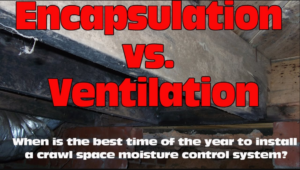One of the common questions that we get from our customers is, “when is the ideal time for us to install a crawlspace moisture control system?” This is a good question, as most people will react cautiously to certain symptoms before they reach out to a crawlspace moisture specialist. The majority of our moisture control systems installed here in the Charlotte, North Carolina market are installed between June and September. The hottest and most humid part of the year. Unfortunately, most customers do not take advantage of the cooler, dryer air plentiful during the fall, winter, and spring months to get their crawlspaces dry and under control. The actual ideal installation time to put in a moisture control program would be during the winter months. It is during this time that we can utilize the outside air more aggressively as it is much cooler, drier and more conducive for longer exchanges of air with the crawl space environment based on a factor of dewpoint.

As these systems can be a significant investment for the consumer, it is understandable why customers would want to wait until summer to install a system when symptoms are more pronounced. Often, clients will report cupping floors, sticking doors, cracks in walls and over doors, odors and smells, as well as heavy condensation drip falling from the duct work under the crawl space floor system. By the time these symptoms occur, cosmetic damage and potential structural wood rot inside the crawl space has occurred combined with the development of mold and other biofilm contaminates on the outer layers of the floor system due to many months of moisture saturation and build up. At this point, often drastic steps need to be taken quickly to ongoing symptoms often requiring the extra drying power of a commercial dehumidifier combined with large drying fans helping to reduce moisture for 48-72 hours first before cleaning any mold and/or repairing damaged framing members and/or installing the primary moisture control system.
Customers can save thousands of dollars by getting their crawlspaces under control during the winter months. The ideal installation time would be between late September and early May. Exchanging with the outside air during these critical months will allow the floor system to dry out thoroughly as well as giving the customer a head start against the buildup of moisture during the next summer cycle. Moisture intrusion follows a dew point style parabolic curve with a climax occurring in July and August. If you start with a dry crawl space in the fall, winter, or spring months, it is often much easier to keep the crawl space dry in June right before the heavy moisture season begins.
As crawlspace moisture and air quality specialists, we have the ability to install either sealed crawl space systems (encapsulation) and/or the advanced hybrid technology called ATMOX Controlled Ventilation. Both technologies resolve the crawlspace moisture challenges with a guarantee but there are some key differences between the two programs. Most contractors and homeowners have researched and discovered sealed crawlspace protocols most commonly called encapsulations due to the huge manufacturer and franchising marketing push on social media and the internet that has occurred promoting that particular concept over the last 15-20 years. As an alternative, customers may choose to stay inside vented code utilizing the more energy efficient, healthy air friendly hybrid technology called ATMOX controlled ventilation that not only solves the moisture problem with an advanced sensor package and control apparatus, but combines the application with the more energy conscious, low voltage fan technology that benefits the structure by utilizing the outside air into the whole house envelope when available to keep air quality inside the home at its highest possible levels. Sealed crawlspaces rely completely on dehumidification from a commercial dehumidifier and/or HVAC forced air situation to reduce just a few pints of water. These are older approaches that have some inherent flaws and vulnerabilities.
· Sealed crawlspaces require sealing up the crawlspace which destroys crawl space air quality and fresh air exchange.
· Sealing up crawl spaces is counter active to the stacking effect that allows for the natural flow of air from the crawl space upwards into the attic. Especially in older houses built between 1900 and 1940. It is important to note that it is impossible to encapsulate an old house.
· Sealed crawlspaces require an expensive commercial dehumidifier to reduce moisture correctly.
· Commercial dehumidifiers are energy hogs requiring 800 to 1200 Watts of power to operate. This could raise your power Bill up $10-$50 per month depending on the situation.
· Dehumidifiers don’t run efficiently inside crawl spaces often over drying the crawl space framing members causing hardwood floors to shrink and crack. Especially between October and May.
· Sealed crawlspaces do not stop the off gassing from soil gases, construction materials, vapor barriers, insulation, foam board, spray foam products and/or musty smells created from mold and other biofilm contaminates that may be infesting the framing members that can migrate upwards into the living areas.
· Sealed crawlspaces require the installation of an expensive fiber reinforced liner that customers can often smell after installation. Often reported as a “Cat Urine” Smell.
· HVAC systems may require expensive upgrades to meet specific code requirements in your area when installing sealed systems (encapsulations). Especially when being utilized for a forced air situation and/or when natural gas is the primary heat source.
· Pest control companies will cancel termite bonds when they see sealed crawlspace systems and/or encapsulations since it is almost impossible to inspect for termite tubes accurately. Even with the 3” safety gap applied that is required by code.
As an alternative to a sealed crawlspace system, customers may want to consider utilizing the newer hybrid technology available called the ATMOX controlled ventilation system. Please See the attached link for a case study performed by a local structural engineering firm:
A controlled ventilation system still retains the qualities of the traditional sealed crawlspace system but uses a more eloquent and technologically friendly and healthy approach to utilize the outside air when conducive for air exchange. Most of the vents are closed and sealed off just like an encapsulation except for a select intake and exhaust port. Louvers are available if desired to create a fully closed space when the system is inactive and idle. The advanced technology uses low voltage on the primary fan system and in certain cases completely negates the need for an expensive commercial dehumidifier completely depending on age of the home, type of foundation, and the cubic square footage available inside the space. Air turnover being the key and the basis to any proposed moisture control solution. There are many additional advantages.
- Controlled ventilation is cheaper to install on large crawl spaces over 2000 square feet saving our customers thousands of dollars on the combined project.
- Utilizes the existing crawlspace vents already available on the house.
- Utilizes an advanced array of interior and exterior sensors including wood moisture sensor and sump pump alarm if needed to ensure the system operates at peak performance at all times.
- Flexibility with easy controller access enables the customer to review conditions outside the house and under the house conveniently without inspecting the crawl space.
- Introduces fresh air into the whole house envelope which improves overall air quality.
- Uses low voltage technology on the primary system.
- Does not require expensive HVAC upgrades.
- Does not require installation of a fiber reinforced liner under the house. Contractor class liners are just fine which helps eliminate odors and cost to the install.
- Does not complicate termite inspections requiring pest control companies to cancel termite bonds.
- Often negates the need for an expensive dehumidifier. And if one is needed, it is utilized as a backup supplemental device on the system for extra drying power when applicable.
- Prevents the floor system from over drying keeping hardwoods from shrinking and cracking during the fall, winter, and spring months. The latest controller upgrade can actually bring in moisture during the winter months on a damp day to help re-hydrate the framing if needed.
For more information on sealed crawlspaces, encapsulations, and/or Atmox controlled ventilation systems please feel free to reach out to us for more information. If at all possible, install your system during the fall, winter, or early spring to save thousands of dollars on the project. We appreciate you reading this article and I look forward to future correspondence. And remember,
Don’t Encapsulate! Ventilate!
